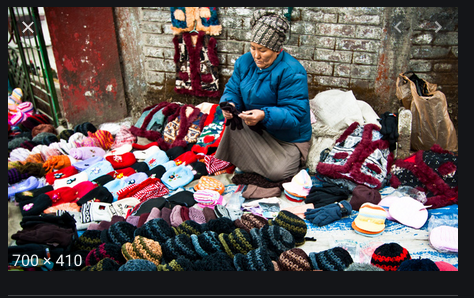
The vast majority of Tibetans in exile make their living selling sweaters. To learn about their lives is to know the story of both the challenges and triumphs of the Tibetans in exile.
Historical Background
The Tibetan community’s story in exile would not be complete without that of the sweater sellers. I believe their tale is one of hard work, resilience, adaptability, and being enterprising. It is also a story of courage and overcoming massive challenges to build new lives for themselves.
My parents were nomads in Tibet, and they had no skills or training to prepare them for their newfound poverty or their new lives in exile. Like most other Tibetan refugees, my parents started their new lives breaking stones by the roadside as road construction labor at minimum wage. This story is true for almost all Tibetans seeking new lives in exile.
The First Sweater Sellers
Someway along the way, the Tibetans found an almost miraculous way out of this unpleasant life of labor – they started selling sweaters and woolen garments and became roadside hawkers. Although there are several theories, no one knows with certainty who the first person or group of persons was who began to sell sweaters. But whoever started it paved a way forward for thousands. One might think that this was not too big a shift, or that becoming a roadside hawker doesn’t sound too significant a rise in life. But it was indeed a massive shift because it was a shift from hard physical labor to enterprise and business. It was a shift from minimum pay to whatever your enterprise could fetch you. Even though the footpaths for their enterprises were far from glamorous, some were making good money – huge money relative to what they made as road construction laborers.
Necessity is the mother of all inventions. In exile, Tibetans discovered a gift they did not know they had – the gift of thrift and enterprise. In Tibet, they were either farmers or nomads with a scattering of traders. Our traders did okay, but we did not have a name or reputation for thrift. In exile, we surprised ourselves with our ability to seek out the best suppliers and find ways to sell and survive. The early roadside hawkers, the ones who did this business say in the seventies and eighties, many or most of them were not only illiterate; they spoke very little Hindi. Yet they found ways to communicate with their customers, found ways to bargain, and found ways to eke out a livelihood.
Overcoming Challenges
No part of this business was easy. It started with the buying process, and this was mostly in the industrial Indian city of Ludhiana – a major center for hosiery sales. The buying process was filled with some amount of risk and tension. The business’s success depended heavily on buying smartly – making sure that you are buying clothing and styles that are in fashion, that are in high demand, paying attention to details – making sure that you have all the different colors, sizes makes, etc. Physically it was challenging and taxing. Wheeled carts and trolleys are just not used -maybe because the alleys are too narrow. Instead, the traders carried huge sacks from one shop to the other, filling them with their merchandise. No one shop sold all items a trader needed. A Tibetan buyer would have to visit several shops, spanning several days to complete the buying part of his business.
The next part was shipping the merchandise to the destinations where they would do business for that season. After several decades of doing this, now Tibetans have figured this out, pay all applicable taxes, and finding suitable carriers. For many years this part of the business was filled with both confusion and risk. Taxation, toll booths, and licenses are, thankfully, streamlined nowadays. Earlier, there was a bewildering number of tolls and taxes, often differing from state to state. Tibetan traders were just not sure about all the rules and regulations. In such situations, some of them would take risks, offer prayers, ship their merchandise without filling in the forms, or paying all the taxes required. They would sort of sweat it out for the stuff to make it! It was risky and filled with tension. Again, they learned and learned quickly, figured out the system, and sometimes even ways to beat it!
The Pain of Being Stateless
One would think that the next part of this business has got to be the selling part. Not quite. For groups of Tibetan refugee traders, the next challenge is to find a spot – a stretch of road or some area where they can set up their temporary shops. Finding that spot is never easy, and there were significant local differences – sometimes in the same location but for different years. This is when it felt sad at not having a country of your own because it can be so difficult to procure that small patch of space. Always you approached the local authorities with folded hands, and many times people were mean or miserly. Often the Tibetan traders were shunted to back alleys or side roads where foot traffic is low and business chances not bright. At some other times, they were allotted filthy spots, where people would hesitate to pass through leave alone do business. The traders would put on face masks, roll up their sleeves, dig out the dirt and filth and make for themselves space good enough, clean enough to do business. Often they had to acquiesce to unfair demands from local municipal officials or greedy law enforcement officers. To their credit, they took everything in their strides – focused simply on surviving and taking care of their families.
Relative Success
Today, there are Tibetan refugee markets in scores of towns and cities in India – all quite distinctive with temporary roofs and plastic sidings. Some of them even have a semblance of permanence built on many years of doing business at the same location. But every one of these was built on the sweat and toil, and in the face of immense challenges. For me, the story of the Tibetan roadside hawker is also the story of Tibetan resilience and never say die attitude. There have been times when they have been demeaned and belittled. One could write a book on all the trials and tribulations of these traders. Yet, it would not be proper if we did not acknowledge the support of both the central and local Indian governments for the Tibetans. Over the years somehow they have accommodated the Tibetan traders, found them so space, and allowed them to do their business. With a little bit of support and their determination, they have managed to overcome their challenges and have found a way, not an easy one, but not a demeaning one either, of eking out a livelihood for themselves. Today, many of them are relatively successful, are comfortable, own cars, and passing down the business to their children.
They’ve forged excellent relationships with their suppliers in Ludhiana. Many of these shopkeepers have come to both respect and trust the Tibetan traders. So much so, they will loan considerable amounts to the traders, often with no other surety than a signature or thumbprint. There is this symbiosis between them out of mutual respect and benefit. Some relations have spilled into genuine friendship and admiration. And then, there are amusing stories too. There was this Indian supplier who had a huge nose. Among themselves, his Tibetan customers used to call him Lala Naku Chenpo – the shopkeeper with the big nose! In time he came to know this, but instead of taking offense, imagine the surprise of the Tibetan traders when he gives them his business card with those same words the Tibetans loved to call him!
Adapting & Changing Family Roles
The story of the Tibetan sweater seller is also about adjusting, adapting, and even changing traditional family roles. Very early on, the Tibetans discovered that their women were better at sales than their men. Quietly and even effortlessly, family roles switched. The menfolk were happy to cook, clean, and do all the family chores during their business season when their women focused on the more important business of selling.
Initially, this trend surprised many Indians – almost all Indian shopkeepers are male. Some may have even thought poorly of their Tibetan male counterparts for their secondary role. With time, most of them have come round to admire the Tibetan adaptability and the immense hard work and long hours their women put on.
All those years of struggle and hard work are finally paying off. When the Indian middle classes’ income started to go up, their business took off at the turn of the century. They’ve adapted to change too – instead of the old time-consuming bargain system, they now have a fixed price system. The buying has become more comfortable with all the trust built over the years, and they’ve figured out the shipping system.
Marketing Tools or the Lack Thereof
I’ve been fascinated by how slick, and sophisticated sales and marketing technologies are here in America. I realized how little the Tibetans knew about these techniques with both amusement and sadness. Year after year, the part that would eat into their profits was leftover or unsold goods. I’ve heard stories where some traders would physically carry loads of their unsold goods on the shoulders and then wander from street to street trying to find customers. I think they could have done so much better if they knew some of the sales and marketing tools people now use. Buy One Get One Free would have worked so much better than the physical hardships of carrying them around on their shoulders. Or, when you are down to those last items that will not sell, and you don’t want to pay storage till the next season, how about Take An Additional 25% on already reduced prices!
Living in the Present
As is often the case with people who work hard, the Tibetan sweater sellers as a tribe, worked hard and then enjoyed themselves and partied hard. Often their selling season would end close to LOSAR, the Tibetan new year. If they had a good season, and, invariably, they would, they would celebrate Losar in style – spend a good portion of their profits in painting their homes, decorating their altars, buying new clothing for all family members. Beer and chang lovers will indulge, meat and food lovers too had their fill. They would sing and dance until the morning’s wee hours – just having a good time and de-stressing after a long winter of solid hard work.
Two of my favorite cousins have been sweater sellers for over forty years, and I’ve followed their lives with interest and even respect. I’ve sometimes admired and envied the relative freedom of their work, their travels, and their income. Yet having lived this life for these years, they know the struggles, the tensions, and the hardships they face as roadside hawkers. They brave it with dignity and hard work, but not all sweater sellers wish this for their children. They would love to educate their children and find other careers for them. As a school administrator, the parents who pushed the hardest for admission, who most wanted education for their children, have often been the Tibetan sweater sellers.
Today when I reflect on our shared experiences in exile, I hold the Tibetan sweater sellers with admiration and gratitude. Their hard work, adaptability and versatility found us a way out of physical labor and poverty in exile. Their lives reflect the determination and courage of the Tibetan people in exile.





